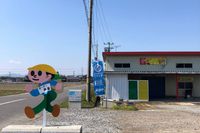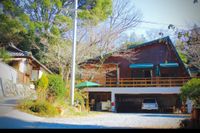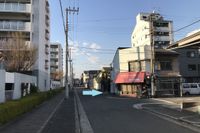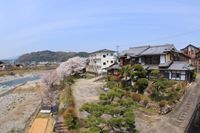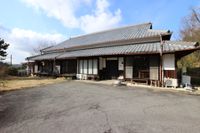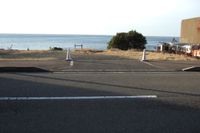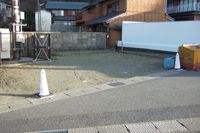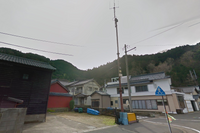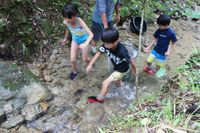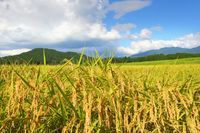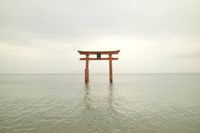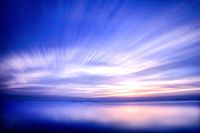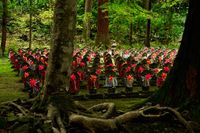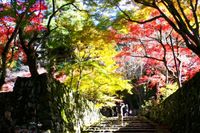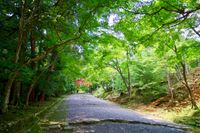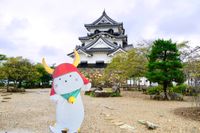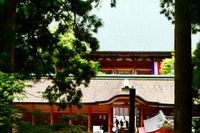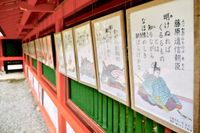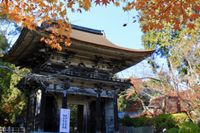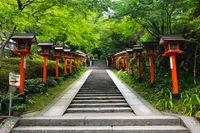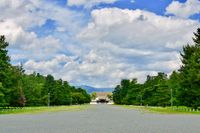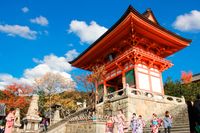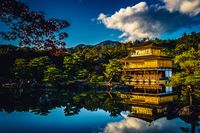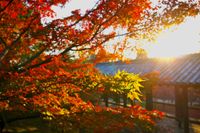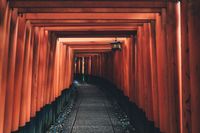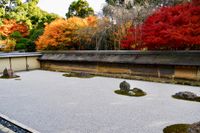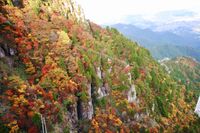Ikiyasan Chomeiji Temple
滋賀県/近江八幡市

Description
This is a Tendai sect temple that was built in 619 AD under the instruction of Prince Shotoku. The objects of worship are Senju Kannon(1000 Armed), Juichimen Kannnon(11-faced) and Sho Kannon and is a hidden temple not normally well known. From the Lake Biwa coast up to the main temple hall there are about 800 steps, known as the "808 steps". The temple is said to bring long life as the pronunciation of the name "Choumei" which is the name of the temple, means "long life" in Japanese.
Homepage
Address
Nearby Car Night Spots
Shin Meishin Suzuka PA (inbound) RV Station Suzuka * With Power!
¥2,200〜
/ per nightMie Yamamotocho, Suzuka-shi
4.3
(156)(Bonfire BBQ) Chita Mihama Noma Beach Station
¥3,500〜
/ per nightAichi Noma, Mihamacho, Chita County
4.7
(42)Nearby Activities
Catch and eat char in a beautiful valley in the mountains
¥2,000〜
/ per personShiga Fujise, Taga-cho Inukami-gun
3.0
(0)All you can eat rice balls and rice reaping in the rice field in the mountains
¥2,000〜
/ per personShiga Fujise, Taga-cho Inukami-gun
3.0
(0)Ranking Stations
(Bonfire BBQ) Chita Mihama Noma Beach Station
¥3,500〜
/ per nightAichi Noma, Mihamacho, Chita County
4.7
(42)Vanlife BASE | 45 min. from Narita Airport / Perfect for campervan travel/A seaside town rich in nature/Japanese countryside town/welcome traveler
¥7,000〜
/ per nightChiba Koseki, Kujukuri-machi, Sambu-gun
5.0
(61)Shin Meishin Suzuka PA (inbound) RV Station Suzuka * With Power!
¥2,200〜
/ per nightMie Yamamotocho, Suzuka-shi
4.3
(156)Nearby Drive Spots
Shirahige Shrine
This is a shrine that is said to have been built in 5 BC. The shrine God is known as Sarutahiko no Mikoto, with the red/orange Torii gates appearing to float in Lake Biwa, which is known as "Itsukushima Shrine of Omi". It is a particularly good photo spot for photographers. The Torii gates were originally on dry land, but it is said that due to the increasing water levels of the lake, the Torii gates ended up being in the lake area.
Lake Biwa
This is a lake with the largest reservoir capacity in Shiga prefecture. It is said that the lake formed from around 4,000,000 to 6,000,000 years ago and provided a water supply to those that lived in the area from the Jomon period. The name comes from the fact that the shape of the lake resembles a Japanese musical instrument known as the Biwa.
Kongorinji Temple
This is a Tendai sect temple built in 741 by Gyoki. The object of worship is Sho Kannon and after it became assigned as a holy place of Buddhist training by the Ennin Priest who practiced at Mount Hiei, it became the branch temple of Enryakuji Temple. It is famous for the countless Ksitigarbha (buddha that looks over children, travelers and the underworld) known as the "Thousand Jizou". As the main hall is separated from the main gate, it is thought that it escaped burning down from the attack of Oda Nobunaga.
Saimyoji Temple
A Tendai sect temple built by Sanshu in 834 AD. The primary object of worship is Yakushi Nyorai, and Minamoto Yoritomo is said to have come here to pray for war victory. Along with the temples Kongorinji Temple and Hyakusaiji Temple, it is one of the "Koutousanzan" destinations (east lake three mountains). It is also famous for autumn leaf viewing, attracting numerous visitors each year.
Hiyoshi Taisha Shrine
This is a shrine built in 91 BC. The western hall contains the main powerful God with the eastern hall contains the Mount Hiei guardian God. This is the main hub shrine of the 3,800 Hiyoshi, Hie and Sannno Shrines in Japan. There are numerous cultural items associated with monkeys, as they are considered as underlings to the shrine Gods. The area is also famous for autumn leaf viewing with around 3000 autumn leaf trees.
Hikone Castle
This is a castle that was built by Ii Naokatsu in 1622. It is famous as one of Japan's only 12 remaining castles, and is one of five that is designated as a national treasure. From the top of the tower, visitors can see magnificent views of Lake Biwa, There is also a moor boat that is still in use, from which Hikone Castle can be viewed, and whose views can be enjoyed along with the seasons.
Mount Hiei Enryakuji Temple
This is a temple of Tendai that was founded by Saicho in 788 AD. It is also registered as a World Heritage Site. Along with Mount Koya Kongobuji Temple, it became the centre for Heian Buddhism and a place of training for figures such as Honen (founder of the Jodo sect), Shinran (founder of the Jodoshin sect), Eisai(Founder of the Rinzai sect), Dogen (founder of the Soto Sect), Nichiren (Founder of Nichiren Sect). Because of this it is also known as the "Mother Mountain of Japanese Buddhism" and sacred buddhist teachings still continue to this day.
Omi Jingu Shrine
This is a shrine built in 1940 to commemorate the 2600th year of the Emperor Jinmu, who was crowned in 660 BC. The temple God is known as Emperor Tenji, who made the trip from Asuka to Omi in 667 AD. After the Emperor Tenji wrote the Ogura Anthology of One Hundred Tanka‐poems by One Hundred Poets, it became a venue for playing Karuta (a variety of card games, normally played around new years). It is also the setting for the anime "Chihayafuru", and many fans of the anime make the pilgrimage here.
Nagarasan Onjoji Temple
This is a temple that was built in the 7th century under the instruction of Prince Yota. It is the head temple of the Tendai-jimon sect. From ancient times, battles and conflicts were waged with Hiei mountain Enryakuji Temple, and was confiscated by Toyotomi Hideyoshi. It is known as the "Phoenix Temple" due to overcoming numerous hardships and being rebuilt each time. Starting with the main hall, the temple contains 10 national treasures and 42 items of designated cultural importance.
Kifune Shrine
This is the head shrine of the Kifune Shrine group, of which there are around 450 in Japan, although the construction date is unknown. The main shrine God was historically known as a rain God named "Takaokami no Kami", and worshipped as a bringer of rain and bountifulness. It is also said that drawings of horses were made on wood here, giving birth to the "Ema" which are the wooden plaques that one can see at many shrines with prayers written on them. Around 300 meters away from the main hall, one can visit "Yui Shrine", where there is another God that is said to bring destined couples together, known as Iwanagahime no Mikoto. The area is popular amongst couples.
Koga Ninja Village
This is a Koga Style Ninja Theme park that opened in 1983. Within the park, there is a Koga Ninja museum which houses the largest number of Ninja tools and exhibits in the world, as well as the original residence of the famous Ninja known as Fujibayashi Yasutake, which was deconstructed and rebuilt as a Ninja trick house. There are other sporting Ninja experiences available such as Shuriken sword fighting and "Mizugumo" - crossing rivers on small raft like objects.
Kyoto Imperial Palace
For 500 years between 1392 and 1869, the various generations of emperors lived here, where public ceremonies were held and administration took place. Originally, the place began as a small hall known as "Tsuchimikado Higashi no Toindono", but was expanded by Ashikaga Yoshimitsu, an important Shogun in Japanese history. It was established by Oda Nobunaga and Hideyoshi Toyotomi, to become the place as it is seen today. It ended as a place of government when the Emperor Meiji and royal family moved to Tokyo in 1869, and became open to the public from August 2016.
Kiyomizu-dera Temple
This is a Hosso sect temple built by Enchin in 778 AD. The temple is built is reverence to Senju Kannon(1000 Armed) and is registered as a World Heritage Site. There is also a 13 meter high famous hall known as the "Kiyomizu Stage", which was built under the instruction of Tokugawa Iemitsu, where it became the stage for performances such as Gagaku classical music, Noh theatre, Kyogen and Kabuki. The temple can be enjoyed in all four seasons with cherry blossoms, greenery, autumn leaves and snow views during the respective four seasons.
Daigoji Temple
This is a Shingon sect temple built by Shobo in 874 AD, and is a branch temple of Shingon sect head temple. Yakushi Nyorai is the primary object of worship, and the temple is registered as a World Heritage Site. Although it was destroyed during the unrest of the Muromachi Era(1336-1573), it was reconstructed as the stage of a famous play starring the hero Toyotomi Hideyoshi, known as the "Daigo no Hanami". It is also famous for cherry blossom viewing.
Kinkakuji Temple(Golden Pavilion)
This is a Rinzai sect temple built by Ashikaga Yoshimitsu in 1397. Kannon Bosatsu is the main object of worship, and is registered as a World Heritage Site. The golden Shariden temple known as "Kinkaku" in the centre of the Garden is said to represent paradise in this world. In the Kyoko-chi Pond, there are several stone islands known as Ashihara-jima islandTsurushima islandKameshima island dedicated to the feudal lords who served Ashikaga Yoshimitsu, the Shogun whose home the temple was. Along with Ginkakuji Temple(Silver Pavilion), these two temples are the great symbols of the Muromachi era(1336-1573).
Tofukuji Temple
This is a Rinzai sect temple built in 1236 by Enni, and is a branch temple of Rinzai Tofukuji sect head temple. The main object of worship is Shaka Nyorai, and the name takes one character from the Todaiji Temple and Kofukuji Temples respectively. The oldest gate in Japan is here, which was rebuilt by Ashikaga Yoshimochi in 1425, and is a designated national treasure. In addition from the Tsuten bridge, provides optimum views of the vivid autumn leaves, and is said to be the best autumn leaf viewing spot in Kyoto.
Fushimi Inari Taisha Shrine
Built in 711 AD, this shrine is the main central temple of the Inari Shrine group, of which there are about 30,000 in Japan. The main Gods are Ukanomitama no Mikoto , Satahiko no Okami, Omiyanome no Okami, Tanaka no Okami, Shi no Okami, known as the Inari great Gods. The shrine has long been known as a place to pray for wish for abundance, and the countless red/orange Torii gates were built to express the power of abundance of the Inari great shrine God, and is known as the "Thousand Torii gates". It was also the scene for the film "Memoirs of a Geisha".
Ryoanji Temple
This is a Rinzai sect temple built by Hosokawa Katsumoto in 1450. The main object of faith is Shaka Nyorai, and is registered as World Heritage Site. The famous stone water garden known as "Karesansui Garden" is said to represent a Zen landscape, and is arranged such that one cannot see all 15 stones at the same time. The area became famous when UK's Queen Elizabeth II visited here in 1975.
Mount Gozaisho
This is a mountain 1,212 meters in height, on the border between Mie and Shiga prefectures. In Spring there are the azalea and spring blossoms, summer brings the red dragonflies, autumn has its red, orange and yellow leaves, and winter brings frost covered trees. Tounaiheki is a famous rock climbing area in this mountain, and hiking can be enjoyed here during any of the four seasons. ※御在所岳 紅葉 © 菰野町 クリエイティブコモンズライセンス(表示4.0 国際)https://creativecommons.org/licenses/by/4.0/
Byodoin Temple
This is a temple built in 1052 by Fujiwara Yorimichi and is registered as a World Heritage Site. The main object of worship is known as Amida Nyorai, and displays the luxurious aristocratic culture of Fujiwara clan. In the central island of the pond, there is what is known as the phoenix temple, and it appears as if there is a palace floating in the middle of the pond in a treasure paradise. You can see the phoenix design on 10 yen coins and 10,000 yen notes.

